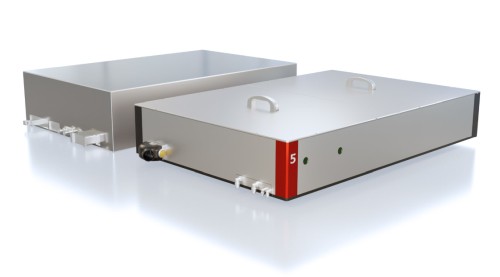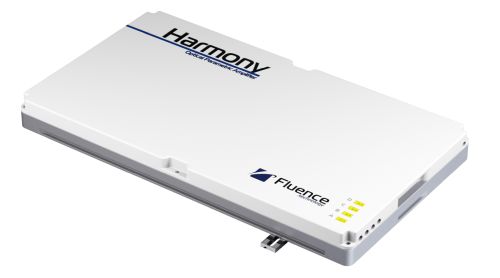ultrafast amplifiers (original) (raw)
Definition: amplifiers for ultrashort (femtosecond or picosecond) optical pulses
Alternative terms: ultrashort pulse amplifiers, femtosecond or picosecond amplifiers
Categories:  optical amplifiers,
optical amplifiers,  light pulses
light pulses
- ultrafast amplifiers
Related: Raman Scattering in a Fiber AmplifierParabolic Pulses in a Fiber AmplifierSoliton Pulses in a Fiber Amplifieroptical amplifiersmultipass amplifiersregenerative amplifierschirped-pulse amplificationdivided-pulse amplificationultrafast lasersAll-in-One Ultrafast Laser Systems
Page views in 12 months: 603
DOI: 10.61835/bwz Cite the article: BibTex BibLaTex plain textHTML Link to this page! LinkedIn
Content quality and neutrality are maintained according to our editorial policy.
📦 For purchasing ultrafast amplifiers, use the RP Photonics Buyer's Guide — an expert-curated directory for finding all relevant suppliers, which also offers advanced purchasing assistance.
Contents
What are Ultrafast Amplifiers?
Ultrafast amplifiers are optical amplifiers which are applied to ultrashort pulses. Some of these devices are used for amplifying high repetition rate pulse trains, leading to a high average power whereas the pulse energy remains moderate. In other cases, a much higher gain is applied to light pulses at lower repetition rates, leading to high pulse energies and correspondingly huge peak powers. Enormously high optical intensities, sometimes above 1016 W/cm2, are achieved by focusing such intense pulses tightly on some target.
Kinds of Ultrafast Amplifiers
The following types of pulse generation devices may be involved:
- The seed laser may be an internal or external mode-locked laser, or in some cases a gain-switched laser diode (→ picosecond diode lasers).
- Particularly for pre-amplification with high gain, but moderate power levels, one may either use a fiber amplifier or a bulk regenerative amplifier.
- Further boosting of the output energy and peak power is possible with a single-pass or multipass amplifier.
- There are also optical parametric amplifiers, which can produce very high gain and substantial output energies, but require energetic pump pulses rather than a continuous or quasi-continuous pump source.
Special Challenges in Developing Ultrafast Amplifiers
Beyond the general technical issues of optical amplifiers, ultrafast devices meet a number of additional challenges:
High Gain
Particularly for high-energy systems, the amplifier gain must be huge. As shown in the examples discussed above, a gain of many tens of decibels is often needed.
As single-pass amplifiers are limited in terms of gain, multipass arrangements are frequently used. Very high gain is possible with regenerative amplifiers. Also, it is common to use multiple amplifier stages (→ amplifier chains). For example, one may use a regenerative amplifier plus one or two multipass amplifiers. The last stages are optimized for high pulse energies and efficient energy extraction.
Feedback Sensitivity
A high gain also implies a high sensitivity against any back-reflected light (except for regenerative and parametric amplifiers). Therefore, one often requires Faraday isolators between the amplifier stages. In addition, it is often necessary to carefully avoid extensive optical feedback from the application into an amplifier device because the use of a Faraday isolator after the last amplifier stage may not be feasible.
ASE Suppression
The high gain also implies a strong tendency for amplified spontaneous emission (ASE). To some extent, ASE in laser amplifiers can be suppressed with optical switches such as acousto-optic modulators between the amplifier stages. These switches are opened only for short time intervals around the peaks of the amplified pulses. However, these time intervals are usually still long compared with the pulse duration, so that it is not possible to suppress some ASE background around the pulses. Optical parametric amplifiers are better in this respect, as they provide gain only during the passage of the pump pulse. Also, there is no amplification for light propagating in the backward direction.
Maintaining the Optical Bandwidth
Ultrashort pulses have some significant optical bandwidth, which can be reduced by the effect of gain narrowing in an amplifier, so that the amplified pulses become longer. For pulse durations below a few tens of femtoseconds, ultrabroadband amplifiers are required. Note that gain narrowing is particularly important in high-gain systems.
Management of Nonlinear Effects
Particularly for systems with high pulse energies, various optical nonlinearities can distort the temporal and spectral pulse shape, or may even lead to laser-induced damage of the amplifier via self-focusing. An effective technique for mitigating such effects is chirped-pulse amplification (CPA), where the pulses are first dispersively stretched to e.g. 1 ns duration, then amplified, and finally dispersively recompressed. A less common alternative is divided-pulse amplification. Another important measure is to increase the mode areas in the amplifiers so as to reduce the optical intensities.
Optical Damage
For a single-pass amplifier, efficient energy extraction is possible only if the pulse duration is long enough to reach a pulse fluence of the order of the saturation fluence without causing strong nonlinear effects.
Pumping
Ultrafast laser amplifiers are usually continuously pumped, except for very low pulse repetition rates below the inverse upper-state lifetime. In any case, the required pump power is far lower than the output peak power. This is essentially because one can exploit the energy storage in the laser gain medium.
For optical parametric amplifiers, not offering energy storage, the pump pulse duration is often similar to the duration of the amplified pulses. In some cases, however, the pump pulses can be significantly longer because one can exploit the group velocity mismatch in the nonlinear crystal.
Raman Scattering in a Fiber Amplifier
We investigate the effects of stimulated Raman scattering in an ytterbium-doped fiber amplifier for ultrashort pulses, considering three very different input pulse duration regimes. Surprisingly, the effect of Raman scattering always gets substantial only on the last meter, although the input peak powers vary by two orders of magnitude.
Examples of Possible Performance Figures
The requirements on ultrafast amplifiers in terms of pulse energy, pulse duration, repetition rate, mean wavelength, etc., are very diverse. Correspondingly, very different types of devices are used. The following sections give some typical examples of the performance reached by different types of systems:
Fiber Amplifier
An ytterbium-doped fiber amplifier may amplify a 100-MHz train of 10-ps pulses to an average power of 10 W. (A system with such output performance is sometimes called an ultrafast fiber laser, although it is actually a master oscillator power amplifier device.)
The peak power of roughly 10 kW can be relatively easily handled with a large mode area amplifier fiber. For femtosecond pulses, however, such a system would exhibit severe nonlinear effects. Starting with femtosecond pulses and applying chirped-pulse amplification, several microjoules can easily be reached, or in extreme cases > 1 mJ. An alternative is the amplification of parabolic pulses in a fiber with normal dispersion, and subsequent dispersive compression.
Multipass Bulk Amplifier
A multipass bulk amplifier, based e.g. on Ti:sapphire and realized with a large mode area, may provide an output energy of the order of 1 J at a low repetition rate of e.g. 10 Hz. Strong pulse stretching to a duration of e.g. a few nanoseconds is necessary to limit nonlinear effects. After compression to e.g. 20 fs, the peak power is tens of terawatts (TW); the most advanced large systems already reach peak powers above 1 PW, i.e. in the petawatt domain. Smaller systems generate e.g. 1-mJ pulses at 10 kHz.
The gain of a multipass amplifier is usually of the order of 10 dB. Typically, the overall quite high gain of an ultrafast amplifier system is provided mainly by the low-energy amplifier stages, while the last stage — a multipass bulk amplifier — provides only 10 dB or less.
Regenerative Amplifier
A much higher gain of several tens of decibels is possible with a regenerative amplifier. Made with Ti:sapphire, e.g., such a device may amplify 1-nJ pulses to 1 mJ. Again, chirped-pulse amplification has to be applied to limit nonlinear effects.
Using a regenerative amplifier based on an Yb-doped thin-disk laser head, pulses with durations somewhat below 1 ps can be amplified to hundreds of microjoules without applying CPA. However, the pulse duration can be not nearly as short as with Ti:sapphire.
Optical Parametric Amplifier
An optical parametric amplifier, pumped with nanosecond pulses from a Q-switched laser, can amplify stretched pulses to energies of several millijoules. A high gain of tens of decibels can be achieved in a single pass. For special phase-matching configurations, the gain bandwidth can be very large, so that very short pulse durations are possible after dispersive compression.
Commercial vs. Research Amplifier Setups
There are both commercially sold ultrafast amplifier systems and custom-made research setups in various laboratories:
Research Ultrafast Amplifiers
In scientific researchers, one sometimes requires extreme performance figures close to the limits of what is currently feasible. Such devices may rely on techniques or components which cannot be used in commercial devices due to a lack of stability and robustness. For example, complex fiber-based systems have been demonstrated which contain multiple transitions between fibers and free-space optics. All-fiber amplifier systems can be made, but these do not reach the performance levels of systems containing bulk-optical elements. In other cases, optical components are operated close to their damage threshold; for commercial devices, a larger safety margin is required.
Even such experimental systems may contain substantial commercial devices. For example, one may use a commercial amplifier in unmodified form and add one or more amplifier stages for boosting the pulse energy further. Also, commercial amplifiers may be tweaked further, e.g. to improve certain aspects of pulse quality.
As ultrafast amplifier systems tend to be quite complex and sensitive, a large work effort may be required to get them developed and keep them in a good operating state. There may be interruptions of operation due to unexpected problems, which need to be diagnosed and fixed.
Of course, some research simply relies on a commercial system if the available performance is sufficient for the task. Maintenance may then be fully done by the manufacturer, and the own personell can largely focus on the actual application. This may be more efficient, although the cost of a commercial system is substantially higher than the parts cost of a home-made solution.
Commercial Ultrafast Amplifiers
From commercial ultrafast amplifiers, reliable performance is expected, i.e., proper operation over prolonged periods of time where performance specifications are reliably reached. Typically, this robustness requires larger safety margins, e.g. in terms of damage threshold, and excludes the use of very special parts which would be difficult to procure. Therefore, the performance figures achievable are usually substantially behind what can be achieved in special laboratory setups.
Applications of Ultrafast Amplifiers
Ultrafast amplifiers find diverse applications:
- Many devices are used in fundamental research. Examples:
- They can provide extremely intense pulses for highly nonlinear processes such as high harmonic generation and novel nonlinear optical phenomena.
- Intense ultrashort pulses can be used for the acceleration of particles (e.g. electrons) to high energies.
- Ultrafast spectroscopy allows one to study ultrafast dynamics of chemical processes, molecular dynamics and energy transfer processes (but does not necessarily require high pulse energies). This field is important for material science.
- Terahertz radiation can be generated with ultrafast light pulses and can be used for various scientific and industrial applications.
- Large ultrafast amplifiers are under consideration for the use in laser-induced nuclear fusion (inertial confinement fusion, fast ignition). These would need to reach both extremely high pulse energies and (at least for practical use in a commercial fusion reactor) high pulse repetition rates.
- Other applications are in the industrial area:
- Intense picosecond or femtosecond pulses with moderate energy are interesting for laser material processing. Millijoule pulse energies are required in some cases, while laser micromachining often works with microjoule or even nanojoule pulse energies. Short pulse durations make it possible to achieve very precise cutting of thin metal sheets, for example.
- There are also medical applications:
- Ophthalmology: Precise eye surgery benefits from amplified ultrashort pulses.
- In dentistry, caries removal can be done with amplified pulses in suitable spectral regions.
- Some medical devices such as stents can be fabricated with ultrafast pulse micromachining.
- Bio-imaging with multiphoton microscopy can be important for medical diagnosis.
Suppliers
Sponsored content: The RP Photonics Buyer's Guide contains 33 suppliers for ultrafast amplifiers. Among them:
⚙ hardware
Class 5 Photonics delivers ultrafast, high-power laser technology at outstanding performance to advance demanding applications from bio-imaging to ultrafast material science and attosecond science. Our robust optical parametric chirped pulse amplifiers (OPCPA) provide high-power, tunable femtosecond pulses at user-friendly operation.
Features of the White Dwarf OPCPA 5 W:
- compact and user-friendly
- CEP stability available
- pumped by Coherent Monaco industrial femtosecond laser
- high-performance, ultrafast OPCPA
- pump-probe configuration
- pumped by Yb-based laser up to 300 W and 3 mJ
- our award-winning flagship product
- highest average power OPCPA for demanding applications
- pumped by kW-class Yb:YAG Innoslab amplifiers or thin-disk lasers
⚙ hardware
Based on Cycle's own femtosecond fiber lasers, the company also offers fiber-based amplifiers (EDFA) with a center wavelength of 1550 nm to 1700 nm. This variant of the SOPRANO-CA is a very attractive solution to amplify the output of beam arrival monitors in synchrotron or FEL facilities, for example. Other custom-made fiber amplifiers are available upon request.
⚙ hardware
Find harmony in four perfectly synchronised and precisely tunable wavelength outputs produced by the Fluence Harmony Optical Parametric Amplifier (OPA).
Fluence Harmony is a device that precisely converts ultrafast pulses of one band (e.g. 1030-nm pulses coming from Fluence Jasper) into a set of pulsed laser beams tunable in an extremely broad spectrum of wavelengths, ranging from 210 nm up to 2600 nm. All automated, all software-controlled.
A growing number of ultrafast spectroscopy techniques has prompted the need for a robust and reliable, self-diagnostic device like Harmony. The optical parametric amplifier is fully compatible with all femtosecond lasers and provides automated tuning across the basic tuning range.
Bibliography
| [1] | M. D. Perry et al., “Petawatt laser pulses”, Opt. Lett. 24 (3), 160 (1999); doi:10.1364/OL.24.000160 |
|---|---|
| [2] | J. Limpert et al., “High-power ultrafast fiber laser systems”, J. Sel. Top. Quantum Electron. 12 (2), 233 (2006); doi:10.1109/JSTQE.2006.872729 |
| [3] | P. Russbueldt et al., “Scalable 30-fs laser source with 530 W average power”, Opt. Lett. 44 (21), 5222 (2019); doi:10.1364/OL.44.005222 |
| [4] | T. Dietz et al., “Ultrafast thin-disk multi-pass amplifier system providing 1.9 kW of average output power and pulse energies in the 10 mJ range at 1 ps of pulse duration for glass-cleaving applications”, Opt. Express 28 (8), 11415 (2020); doi:10.1364/OE.383926 |
| [5] | L. E. Zapata et al., “One-joule 500-Hz cryogenic Yb:YAG laser driver of composite thin-disk design”, Opt. Lett. 47 (24), 6385 (2022); doi:10.1364/OL.476964 |
| [6] | F. Salin, “Ultrafast solid-state amplifiers”, in Ultrafast Lasers: Technology and Applications (eds. M. Fermann, A. Galvanauskas, G. Sucha), Marcel Dekker, New York (2002), Chapter 2, p. 61–88 |
| [7] | A. Galvanauskas, “Ultrashort-pulse fiber amplifiers”, in Ultrafast Lasers: Technology and Applications (eds. M. Fermann, A. Galvanauskas, G. Sucha), Marcel Dekker, New York (2002), Chapter 4, p. 155–218 |
| [8] | G. Cerulla and C. Manzoni, “Solid-state ultrafast optical parametric amplifiers”, in Solid-State Lasers and Applications (ed. A. Sennaroglu), CRC Press, Boca Raton (2007), Chapter 11, pp. 437–472 |
| [9] | R. Paschotta, tutorial “Fiber Amplifiers”, part 8 on ultrafast amplifiers |
| [10] | R. Paschotta, tutorial “Modeling of Fiber Amplifiers and Lasers” |
| [11] | R. Paschotta, tutorial “Modeling of Pulse Amplification” |
(Suggest additional literature!)
Questions and Comments from Users
Here you can submit questions and comments. As far as they get accepted by the author, they will appear above this paragraph together with the author’s answer. The author will decide on acceptance based on certain criteria. Essentially, the issue must be of sufficiently broad interest.
Please do not enter personal data here. (See also our privacy declaration.) If you wish to receive personal feedback or consultancy from the author, please contact him, e.g. via e-mail.
By submitting the information, you give your consent to the potential publication of your inputs on our website according to our rules. (If you later retract your consent, we will delete those inputs.) As your inputs are first reviewed by the author, they may be published with some delay.






